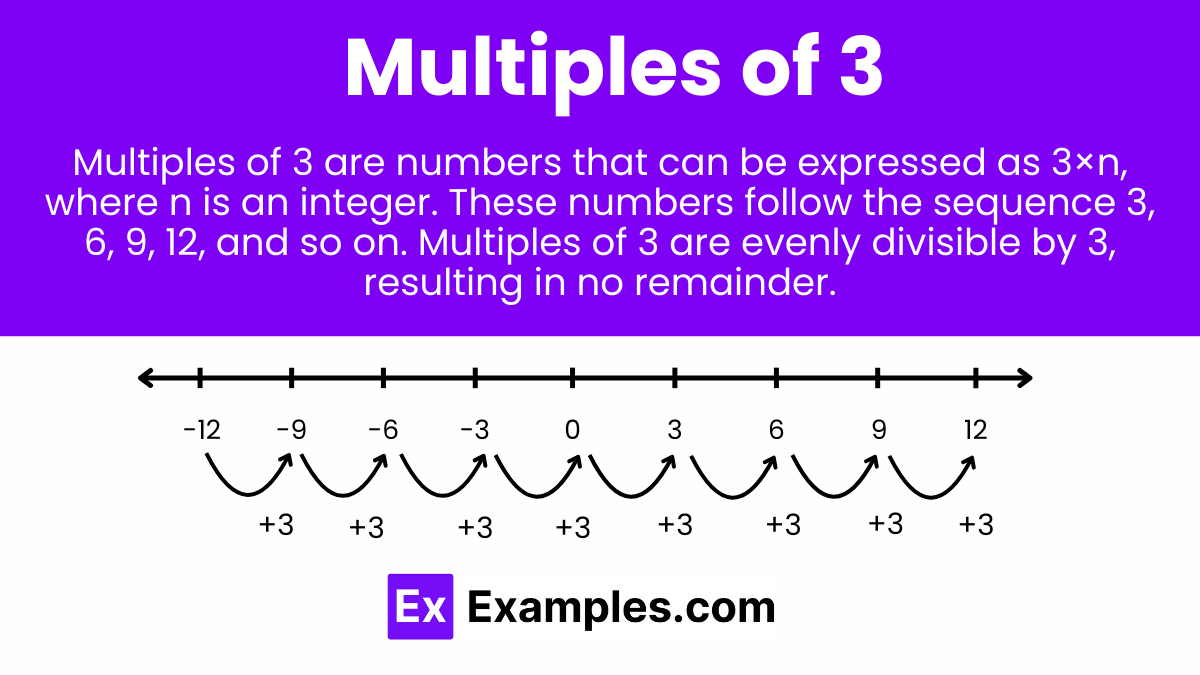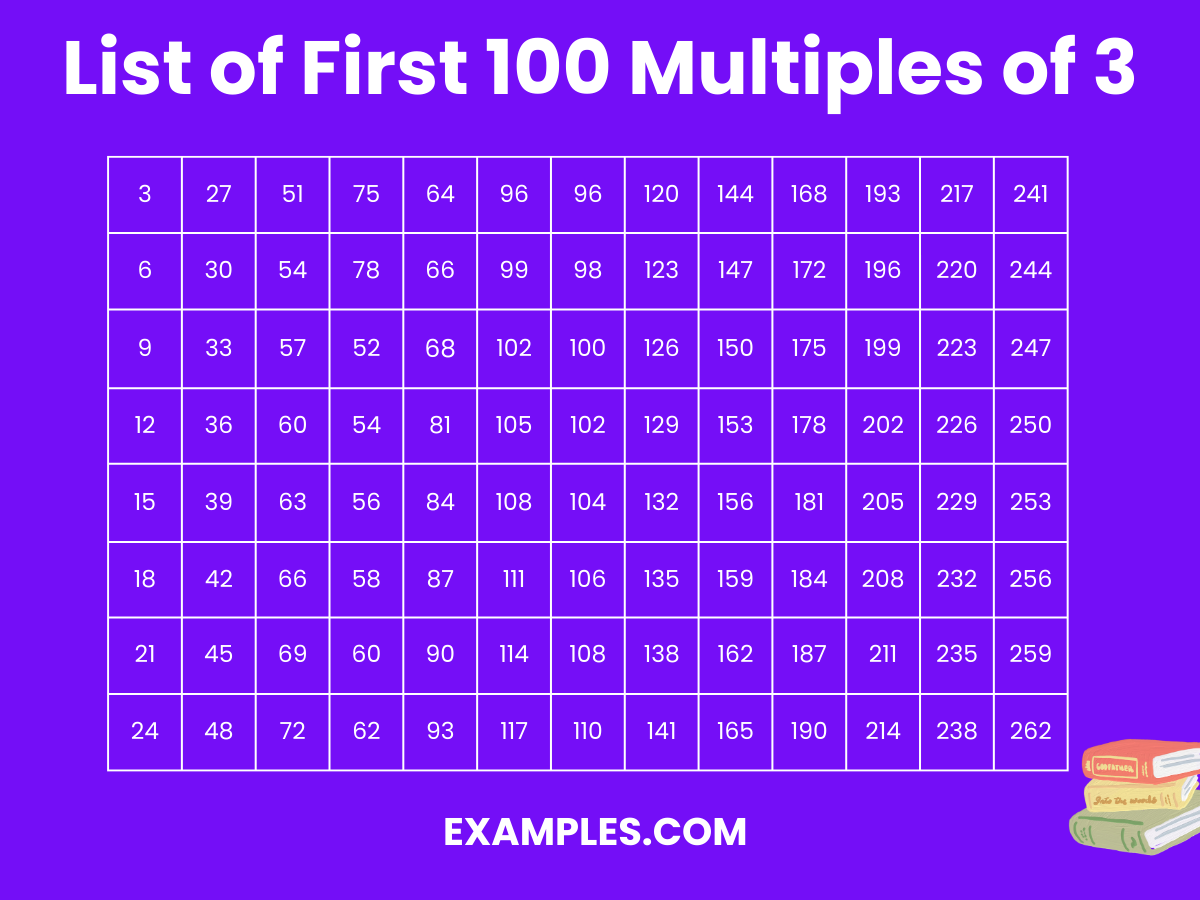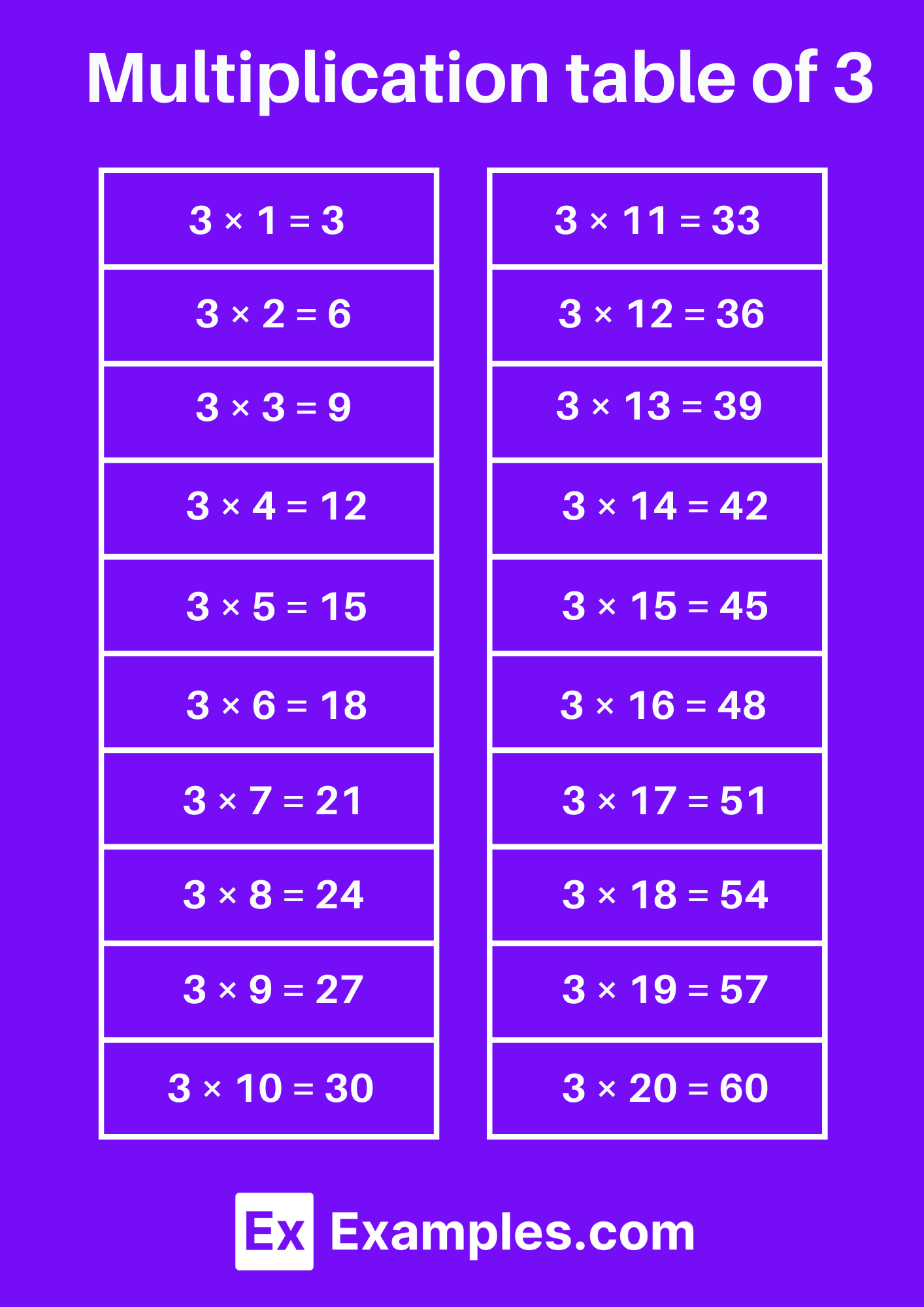Which of the following numbers is a multiple of 3?
11
14
18
22


Multiples of 3 are integers that can be obtained by multiplying the number 3 by any whole number. These numbers, such as 3, 6, 9, 12, and so on, are the result of the multiplication process involving 3. The concept of multiples is closely related to factors and divisors; specifically, a multiple of 3 is any number that 3 can evenly divide without leaving a remainder. Understanding multiples helps in various mathematical applications, including finding common multiples and solving problems involving divisibility.
Multiples of 3 are numbers that result from multiplying 3 by any integer. They are the sequence 3, 6, 9, 12, 15, and so on, where each number is a product of 3 and another whole number. These numbers are divisible by 3 without leaving a remainder.
| Number | Calculation | Remainder |
|---|---|---|
| 15 | 15 ÷ 3 = 5 | 0 |
| 27 | 27 ÷ 3 = 9 | 0 |
| 33 | 33 ÷ 3 = 11 | 0 |
| 60 | 60 ÷ 3 = 20 | 0 |
| 22 | 22 ÷ 3 = 7.33 | 1 |

| Number | Calculation | Remainder |
|---|---|---|
| 3 | 3÷3 = 1, so 3 is divisible by 3. | 0 |
| 6 | 6÷3 = 2, so 6 is divisible by 3. | 0 |
| 9 | 9÷3 = 3, so 9 is divisible by 3. | 0 |
| 12 | 12÷3 = 4, so 12 is divisible by 3. | 0 |
| 15 | 15÷3 = 5, so 15 is divisible by 3. | 0 |
| 18 | 18÷3 = 6, so 18 is divisible by 3. | 0 |
| 21 | 21÷3 = 7, so 21 is divisible by 3. | 0 |
| 24 | 24÷3 = 8, so 24 is divisible by 3. | 0 |
| 27 | 27÷3 = 9, so 27 is divisible by 3. | 0 |
| 30 | 30÷3 = 10, so 30 is divisible by 3. | 0 |
| 33 | 33÷3 = 11, so 33 is divisible by 3. | 0 |
| 36 | 36÷3 = 12, so 36 is divisible by 3. | 0 |
| 39 | 39÷3 = 13, so 39 is divisible by 3. | 0 |
| 42 | 42÷3 = 14, so 42 is divisible by 3. | 0 |
| 45 | 45÷3 = 15, so 45 is divisible by 3. | 0 |
| 48 | 48÷3 =16, so 48 is divisible by 3. | 0 |
| 51 | 51÷3 = 17, so 51 is divisible by 3. | 0 |
| 54 | 54÷3 = 18, so 54 is divisible by 3. | 0 |
| 57 | 57÷3 = 19, so 57 is divisible by 3. | 0 |
| 60 | 60÷3 = 20, so 60 is divisible by 3. | 0 |
| 63 | 63÷3 = 21, so 63 is divisible by 3. | 0 |
| 66 | 66÷3 = 22, so 66 is divisible by 3. | 0 |
| 69 | 69÷3 = 23, so 69 is divisible by 3. | 0 |
| 72 | 72÷3 = 24, so 72 is divisible by 3. | 0 |
| 75 | 75÷3 = 25, so 75 is divisible by 3. | 0 |
| 78 | 78÷3=26, so 78 is divisible by 3. | 0 |
| 81 | 81÷3 = 27, so 81 is divisible by 3. | 0 |
| 84 | 84÷3 = 28, so 84 is divisible by 3. | 0 |
| 87 | 87÷3 = 29, so 87 is divisible by 3. | 0 |
| 90 | 90÷3 = 30, so 90 is divisible by 3. | 0 |
| 93 | 93÷3 = 31, so 93 is divisible by 3. | 0 |
| 96 | 96÷3 = 32, so 96 is divisible by 3. | 0 |
| 99 | 99÷3 = 33, so 99 is divisible by 3. | 0 |
| 102 | 102÷3 = 34, so 102 is divisible by 3. | 0 |
| 105 | 105÷3 = 35, so 105 is divisible by 3. | 0 |
| 108 | 108÷3 = 36, so 108 is divisible by 3. | 0 |
| 111 | 111÷3 = 37, so 111 is divisible by 3. | 0 |
| 114 | 114÷3 = 38, so 114 is divisible by 3. | 0 |
| 117 | 117÷3 = 39, so 117 is divisible by 3. | 0 |
| 120 | 120÷3 = 40, so 120 is divisible by 3. | 0 |
| 123 | 123÷3 = 41, so 123 is divisible by 3. | 0 |
| 126 | 126÷3 = 42, so 126 is divisible by 3. | 0 |
| 129 | 129÷3 = 43, so 129 is divisible by 3. | 0 |
| 132 | 132÷3 = 44, so 132 is divisible by 3. | 0 |
| 135 | 135÷3 = 45, so 135 is divisible by 3. | 0 |
| 138 | 138÷3 = 46, so 138 is divisible by 3. | 0 |
| 141 | 141÷3 = 47, so 141 is divisible by 3. | 0 |
| 144 | 144÷3 = 48, so 144 is divisible by 3. | 0 |
| 147 | 147÷3 = 49, so 147 is divisible by 3. | 0 |
| 150 | 150÷3 = 50, so 150 is divisible by 3. | 0 |
| 153 | 153÷3 = 51, so 153 is divisible by 3. | 0 |
| 156 | 156÷3 = 52, so 156 is divisible by 3. | 0 |
| 159 | 159÷3 = 53, so 159 is divisible by 3. | 0 |
| 162 | 162÷3 = 54, so 162 is divisible by 3. | 0 |
| 165 | 165÷3 = 55, so165 is divisible by 3. | 0 |
| 168 | 168÷3 = 56, so 168 is divisible by 3. | 0 |
| 171 | 171÷3 = 57, so 171 is divisible by 3. | 0 |
| 174 | 174÷3 = 58, so 174 is divisible by 3. | 0 |
| 177 | 177÷3 = 59, so 177 is divisible by 3. | 0 |
| 180 | 180÷3 = 60, so 180 is divisible by 3. | 0 |
| 183 | 183÷3 = 61, so 183 is divisible by 3. | 0 |
| 186 | 186÷3 = 62, so 186 is divisible by 3. | 0 |
| 189 | 189÷3 = 63, so 189 is divisible by 3. | 0 |
| 192 | 192÷3 = 64, so 192 is divisible by 3. | 0 |
| 195 | 195÷3 = 65, so 1195 is divisible by 3. | 0 |
| 198 | 198÷3 = 66, so 198 is divisible by 3. | 0 |
| 201 | 201÷3 = 67, so 201 is divisible by 3. | 0 |
| 204 | 204÷3 = 68, so 204 is divisible by 3. | 0 |
| 207 | 207÷3 = 69, so 207 is divisible by 3. | 0 |
| 210 | 210÷3 = 70, so 210 is divisible by 3. | 0 |
| 213 | 213÷3 = 71, so 213 is divisible by 3. | 0 |
| 216 | 216÷3 = 72, so 216 is divisible by 3. | 0 |
| 219 | 219÷3 = 73, so219 is divisible by 3. | 0 |
| 222 | 222÷3 = 74, so 222 is divisible by 3. | 0 |
| 225 | 225÷3 = 75, so 225 is divisible by 3. | 0 |
| 228 | 228÷3 = 76, so 228 is divisible by 3. | 0 |
| 231 | 231÷3 = 77, so 231 is divisible by 3. | 0 |
| 234 | 234÷3 = 78, so 234 is divisible by 3. | 0 |
| 237 | 237÷3 = 79, so 237 is divisible by 3. | 0 |
| 240 | 240÷3 = 80, so 240 is divisible by 3. | 0 |
| 243 | 243÷3 = 81, so 243 is divisible by 3. | 0 |
| 246 | 246÷3 = 82, so 246 is divisible by 3. | 0 |
| 249 | 249÷3=83, so 249 is divisible by 3. | 0 |
| 252 | 252÷3 = 84, so 252 is divisible by 3. | 0 |
| 255 | 255÷3 = 85, so 255 is divisible by 3. | 0 |
| 258 | 258÷3 = 86, so 258 is divisible by 3. | 0 |
| 261 | 261÷3 = 87, so 261 is divisible by 3. | 0 |
| 264 | 264÷3 = 88, so 264 is divisible by 3. | 0 |
| 267 | 267÷3 = 89, so 267 is divisible by 3. | 0 |
| 270 | 270÷3 = 90, so 270 is divisible by 3. | 0 |
| 273 | 273÷3 = 91, so 273 is divisible by 3. | 0 |
| 276 | 276÷3 = 92, so 276 is divisible by 3. | 0 |
| 279 | 279÷3 = 93, so 279 is divisible by 3. | 0 |
| 282 | 282÷3 = 94, so 282 is divisible by 3. | 0 |
| 285 | 285÷3 = 95, so 285 is divisible by 3. | 0 |
| 288 | 288÷3 = 96, so 288 is divisible by 3. | 0 |
| 291 | 291÷3 = 97, so 291 is divisible by 3. | 0 |
| 294 | 294÷3 = 98, so 94 is divisible by 3. | 0 |
| 297 | 297÷3 = 99, so 297 is divisible by 3. | 0 |
| 300 | 300÷3 = 100, so 300 is divisible by 3. | 0 |

To determine if 45 is a multiple of 3, divide 45 by 3: 45÷3 = 15 Since the result is an integer with no remainder, 45 is a multiple of 3.
To find the first five multiples of 3, multiply 3 by the first five integers:
Thus, the first five multiples of 3 are 3, 6, 9, 12, and 15.
Consider you have 27 apples, and you want to distribute them equally into groups of 3: 27÷3 = 9 You will have 9 groups with 3 apples each. This shows that 27 is a multiple of 3.
Find the sum of the multiples of 3 up to 15:
Therefore, the sum of the multiples of 3 up to 15 is 45.
Identify multiples of 3 between 10 and 30:
You have 18 candies and want to divide them equally among 3 friends. Each friend gets: 18÷3 = 6 So, 18 is a multiple of 3.
If you take 3 steps at a time, after 5 times, you will have taken: 3×5 = 15 Therefore, 15 steps is a multiple of 3.
You have 27 books to pack into boxes, with 3 books per box. You will need: 27÷3 = 9 This means 27 is a multiple of 3, requiring 9 boxes.
Concert tickets are sold in packs of 3. If you need 12 tickets, you will buy: 3×4 = 12 So, 12 is a multiple of 3, and you buy 4 packs.
You want to arrange 30 chairs in rows of 3. The number of rows will be: 30÷3 = 10 Thus, 30 is a multiple of 3, and you will have 10 rows.
A multiple of 3 is any number that can be evenly divided by 3 without leaving a remainder. Examples include 3, 6, 9, 12, and so on.
To determine if a number is a multiple of 3, divide the number by 3. If the result is a whole number with no remainder, then it is a multiple of 3.
The first five multiples of 3 are 3, 6, 9, 12, and 15.
Not necessarily. While some multiples of 3 might also be multiples of other numbers (e.g., 6 is a multiple of both 3 and 2), others may not be (e.g., 9 is only a multiple of 3).
Multiples of 3 are important in mathematics for understanding patterns, solving problems involving divisibility, and finding the least common multiple (LCM) and greatest common divisor (GCD).
Yes, negative numbers can also be multiples of 3. Examples include -3, -6, -9, and so on.
Multiples of 3 are used in various real-life applications such as event planning, packaging, cooking, and financial planning, where grouping or dividing items into sets of 3 is practical.
Yes, zero is considered a multiple of 3 because 0÷3=0 with no remainder.
Multiples of 9 are also multiples of 3. This is because 9 itself is a multiple of 3 ( 9 = 3×3). Thus, any multiple of 9 can be evenly divided by 3.
A number is a multiple of 3 if the sum of its digits is a multiple of 3. For example, for 123, the sum of digits is 1+2+3 = 6, which is a multiple of 3, so 123 is a multiple of 3.
Text prompt
Add Tone
10 Examples of Public speaking
20 Examples of Gas lighting
Which of the following numbers is a multiple of 3?
11
14
18
22
What is the smallest multiple of 3 that is greater than 10?
12
13
14
15
Which number is not a multiple of 3?
27
30
34
38
What is the result of multiplying 3 by 7?
18
21
24
27
Which of these numbers is the result of adding two multiples of 3?
25
30
35
40
Which number below is the largest multiple of 3 less than 50?
48
50
55
60
Which of the following is a multiple of 3 and also a prime number?
3
6
9
12
If you subtract 6 from 15, which of the following is true?
The result is a multiple of 3
The result is not a multiple of 3
The result is 9
The result is 12
What is the next multiple of 3 after 57?
60
61
62
63
Which number is a multiple of 3 and also a perfect square?
9
10
11
13
Before you leave, take our quick quiz to enhance your learning!

